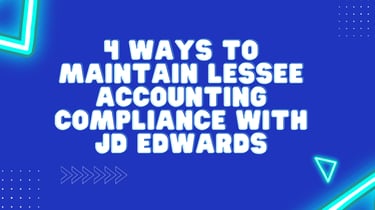4 Ways to Maintain Lessee Accounting Compliance with JD Edwards
 Leasing equipment, real estate, and other assets are not only central to the operations of many businesses, but they’re also playing an increasingly important role. In fact, the Finance and Leasing Association (FLA) reports recent growth of 6% across all sectors. If your business rents assets from others, it’s important that you track these types of activities. Aside from being able to understand how they impact the financial health of your business, lessee accounting is also required by law. The FASB, in 2019, released new lessee accounting standards for the reporting of leases (FASB Update ASC 842 and IASB IFRS 16). Read on to learn what these updates are, how they impact various industries, and how JD Edwards Lessee Accounting (JDE) features make incorporating these changes easier.
Leasing equipment, real estate, and other assets are not only central to the operations of many businesses, but they’re also playing an increasingly important role. In fact, the Finance and Leasing Association (FLA) reports recent growth of 6% across all sectors. If your business rents assets from others, it’s important that you track these types of activities. Aside from being able to understand how they impact the financial health of your business, lessee accounting is also required by law. The FASB, in 2019, released new lessee accounting standards for the reporting of leases (FASB Update ASC 842 and IASB IFRS 16). Read on to learn what these updates are, how they impact various industries, and how JD Edwards Lessee Accounting (JDE) features make incorporating these changes easier.
New Updates and How They’re Impacting Various Industries
The FASB’s new standards require that business report their leases, as their own unique entries, on their balance sheets. This applies to both property and non-property leases, such as:
- Retail space
- Office space
- Warehouses
- Vehicles
- Office equipment
- Construction equipment
- Equipment used for the operation of the business
How the Standards Impact Businesses That Lease Assets
The FASB’s guidelines have a significant impact on how businesses report and keep track of their leases. One of the reasons why the FASB took this action was because its standards board discovered that many companies were overestimating their leasing obligations. This could have been intentional—to realize tax savings—or unintentional due to oversight.
Either way, the FASB’s new standards make it important for a business to accurately identify and report its leasing expenses. This directly impacts virtually all industries. For example, any company that rents office, manufacturing, or warehouse space needs to delineate its leasing obligations on its balance sheets. Also, in the construction industry, every time the company rents a piece of equipment, it needs to be reported. Restaurants that lease equipment, such as ovens or commercial dishwashers, will have to keep track of each item on their balance sheets if they want to remain in line with the FASB’s standards.
How the Standards Impact Lessors
If a company rents equipment, real estate, or other assets to others, the FASB standards require them to report this on their balance sheets as well. They would categorize this income as “Revenue from Contracts with Customers.”
For instance, suppose a construction company owns two trucks that deliver ready-mix concrete to job sites. While most of their income comes from customers paying them to build, they occasionally rent out one of their trucks, sending an operator to pour concrete for other contractors. To remain in compliance with the FASB’s standards, the company would have to record this income as its own entry on its balance sheets.
4 Ways JD Edwards Lessee Accounting Helps with Compliance
JD Edwards makes compliance easier with features that automate some of the work behind adjusting your balance sheets to accommodate the FASB’s standards. These include:
- Importing your lease terms and conditions
- Creating asset amortization schedules
- Making alternate ledgers for leased asset balances
- Updating leases with new terms
1. Import Your Lease Terms and Conditions
With JD Edwards, you can import the conditions and terms of any of your leases using a regular comma-separated value (.csv) flat file. This can be done in EnterpriseOne with the Z table processing feature.
If you want to add leases without importing, that can be done as well using the standard lease entry system. In this way, you have flexibility as to how you ensure your leases are incorporated into your balance sheet.
2. Create Asset Amortization Schedules
You can use JD Edwards Software to make lease liability, as well as right of use amortization schedules before you start following the FASB’s guidelines. This way, you can get your accountants’ input before officially adopting the standard in your JD Edwards lessee accounting.
3. Make an Alternate Ledger for Leased Asset Balances
JD Edwards also allows you to take data from amortization schedules to create an alternate ledger. This feature makes it easier to report lease information retrospectively. Also, you can use this feature before or after adopting the FASB’s standard. This saves time and prevents the confusion and potential errors that could result from manually making an alternate ledger.
4. Conveniently Update Leases with New Terms
For companies that rent real estate, updating your existing leases with the new terms outlined by the FASB’s standards is also straightforward with JD Edwards. If you’re in-between using the old standard and adopting the new one, you can use an option in the Real Estate Constants feature to incorporate the new measures into your system.
Using JD Edwards Is Simple with GSI
With GSI’s JD Edwards consultants, you can take advantage of a full cloud-based JDE implementation. GSI can establish, add-on, manage or upgrade your JDE using a wide range of environments, including public and private cloud, as well as multi- and hybrid cloud—all according to your specific needs. Connect with GSI’s team of JD Edwards experts today to learn more.
